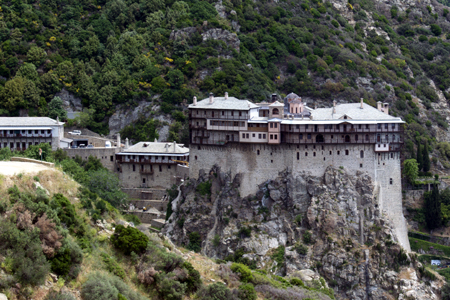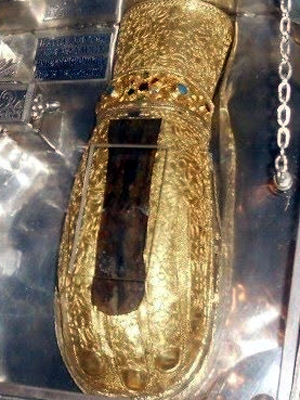| |
 |
 |
 |
| Comment on this report, or find other reports. |
 |
| Our Mystery Worshippers are volunteers who warm church pews for us around the world. If you'd like to become a Mystery Worshipper, start here. |
 |
| Find out how to reproduce this report in your church magazine or website. |
|
|
| 3169: Monastery of Simonopetra, Mount Athos |
 |
 |
 |
Mystery Worshipper: Columba's Currach.
The church: Monastery of Simonopetra, Mount Athos.
Denomination: Eastern Orthodox (independent of any national church, and answerable to the Ecumenical Patriarch of Constantinople).
The building: It is certainly one of the most dramatic religious buildings in the world. It stands on a precipice partially natural, but considerably enhanced by human construction, 300 meters above the Singitic Gulf (a narrow portion of the Aegean). There's been a monastery here since the 13th century, but it's been partially destroyed several times by fire. I gather the present structure dates largely from the late 19th and early 20th centuries, being funded largely by donations from Tsarist Russia, many of them in thanksgiving for miracles allegedly attributable to the relic of the left hand of Mary Magdalene in the monastery's collection. A great deal of construction is still going on to this day.
The church: Simonopetra was founded in the late 13th century by St Simon the Myrrh-Gusher (so called because, according to legend, after his death his body gave off the fragrance of myrrh). Legend also has it that one Christmas Eve, as Simon knelt in prayer, a star appeared that would guide him to Mount Athos. After he arrived, the Virgin Mary came to him in a vision and told him to build a monastery on the spot. Shortly after, he was visited by three wealthy men, brothers, who confessed their sins to him and pledged their entire fortunes to finance construction of the monastery. Today Simonopetra features several chapels, one of which holds the relic of Mary Magdalene's left hand, incorrupted and encased in gold, also exuding the fragrance of myrrh. Simonopetra is also noted for its well-organised library and for its excellent choir and scholarly dedication to Byzantine chant. There are at present 54 monks from different nationalities. When I was there, there were perhaps 30 pilgrims.
The neighbourhood: The question on the Mystery Worship reporting form reads: "Anything interesting or unusual about the immediate neighbourhood?" The better question in this instance would be: "Anything usual about it?" Officially the Autonomous Monastic State of the Holy Mountain, Mount Athos sits on a peninsula in northeastern Greece and is an autonomous polity within the Greek Republic. Homer mentions it in the Iliad. Inhabited since ancient times, the mountain has seen a Christian presence since before Constantine's reign and monastic traditions dating back to AD800. Today Mount Athos is home to twenty monasteries where monks from Romania, Moldova, Georgia, Bulgaria, Serbia and Russia, as well as Greece, live an ascetic life isolated from the rest of the world. Travel to Mount Athos is restricted – people and goods may enter only with permission, and women are prohibited. (Women have, on occasion, entered disguised as men.) Female animals are also prohibited, except for cats, insects and songbirds. For the entire Holy Mountain, there is a limit to just over 100 lay pilgrims, 90 per cent of whom must be baptised Orthodox men. The remaining 10 per cent of lay pilgrims may be of any religion, as long as they are male. Orthodox priests and monks from monasteries outside the mountain may visit without limitation. Mount Athos is a naturally spectacular setting. Anywhere else in Europe, a place with sea views like these would be dotted with luxury resorts. Here, though, it is only monks and a relatively small number of lay pilgrims. It seemed like every stream and rock was associated with some deceased ascetic.
The cast: Various parts of the service were led by several monks, none of whom were named. A visiting Orthodox priest from France also took part. I was informed that the abbot was not present.
The date & time: 11 May 2017, advertised as starting at 4.30am but already in progress when I arrived – it had actually started at 4.00am.
What was the name of the service?
It was not named anywhere that I could see. However, this was the "Dawn Aggregate," consisting of the Midnight Office, the Dawn Office, the First Hour and the Divine Liturgy, all said back-to-back.
How full was the building?
It's difficult to say. Like most churches on Mount Athos, the chapel is divided into four distinct rooms: the outer narthex, the inner narthex, the nave, and the altar (or sanctuary). There were monks in all four of these rooms, and lay people in the first three.
Did anyone welcome you personally?
Not at the beginning of this service. However, I had been welcomed on my arrival the afternoon before, and had been given the traditional welcome treat of water, Ouzo, and Turkish Delight (a starchy-sugary confection containing chopped dates and nuts).
Was your pew comfortable?
It was really more of a misericord, but at least there was one!
How would you describe the pre-service
atmosphere?
As mentioned, the service was already in progress when I arrived. However, some of the monks and virtually all of the lay pilgrims arrived after I did, so there was a constant stream of people entering, venerating icons, and finding a place to stand.
What were the exact opening words of the
service?
I wasn't there for them (see above).
What books did the congregation use during the
service?
The monks chanted from huge leather-bound books on their desks, but there were no books for lay pilgrims.
What musical instruments were played?
Officially none, as the Orthodox do not use instruments. However, I think it would be more accurate to say that various percussion instruments were used. These included bells of various sizes, and the semantron (a wooden beam struck with a mallet). These were sounded during the service as well as before it, and played so rhythmically that I would definitely classify them as instruments. The majority of the music, though, was unaccompanied singing. It was a real treat: the monastic choir of Simonopetra is the most famous on Mount Athos and has recorded several CDs of liturgical music.
Did anything distract you?
What didn't distract me? I didn't understand most of the chanting, which left me with several hours in which to let my mind wander. Various distractions included the fact that many of the monks looked like my first Latin teacher. (He was not, it must be said, actually an Orthodox monk, but he favoured the long untrimmed beard and tiny wire spectacles that seem to be the height of monastic fashion.)
I was also a bit confused about when to stand and when to sit. Unlike most Orthodox services I have attended, we did not stand for the entire time, but few people stood or sat at the same time. For someone used to the quasi-military precision of Anglican choral worship (where people often look to the choirmaster to give a sign of when to sit or stand in unison), this was terribly confusing.
Understanding so little Greek, I mostly zoned out, but I was jolted back to my senses by hearing what sounded like a Romance language. I thought at first I must be imagining it, but then I heard it again and more distinctly: "Dans tous les âges du siècle des siècles." It was the French priest leading part of the liturgy in his native tongue.

Was the worship stiff-upper-lip, happy clappy, or
what?
"Messily hierarchical" is about as close as I can come to describing it. Monks arrived at various points, and occasionally held conversations during the liturgy. Due to my poor understanding of Byzantine Greek, I understood little of what was being chanted. I could just about work out the Trisagion and of course the Kyrie. These and other acclamations were repeated many, many times – the Kyrie as many as forty times in rapid succession.
Unlike most Western monasteries I've visited, where the liturgy is chanted slowly to aid contemplation, here it was chanted at an extremely rapid pace. It seemed that one monk would take over when another got tired, but there must have been more planning to it than that. There seemed to be queues, and as far as I could tell no monk ever missed his turn, and there was no hesitation when one monk finished and another took over.
Exactly how long was the sermon?
There was none.
Which part of the service was like being in
heaven?
Some of the chanting was beautiful, and there is something wonderful about knowing that the community here has been doing this for over 700 years.
And which part was like being in... er... the other place?
I'm rarely one to complain about the length of liturgy. But three and a half hours is simply too much even for me, especially beginning before dawn.
What happened when you hung around after the service looking lost?
I'm not actually sure the service was over. I left with most of the monks and all the other pilgrims, but even then a monk was still chanting.
How would you describe the after-service
coffee?
I had been told there was coffee after this service, but I didn't see any, either in the refectory or guesthouse. I could really have done with some. The coffee on Mount Athos is invariably of the sort known as "Greek coffee" in Greece and "Turkish coffee" everywhere else. It is so thick as to be scarcely liquid, having the consistency of crude oil mixed with sod, and invariably sweetened with huge quantities of sugar.
How would you feel about making this church your regular (where 10 = ecstatic, 0 = terminal)?
0 – That's not possible without me both converting to Orthodoxy and becoming a monk. This service definitely did not inspire me to do either!
Did the service make you feel glad to be a
Christian?
I'm afraid it didn't really impact my view of Christianity one way or the other. I felt I didn't really "get" Athonite spirituality. Although the monks here obviously pray a lot, I didn't feel surrounded by prayer in the same way I have in Anglican and Roman Catholic religious houses. I'm sure that's more to do with cultural differences than with any fault of this community, but it did very little for me personally.
What one thing will you remember about all this in seven days' time?
Probably being surrounded by so many bearded, ponytailed and becassocked monks. |
|
|
 |
 |
 |
| We rely on voluntary donations to stay online. If you're a regular visitor to Ship of Fools, please consider supporting us. |
 |
 |
 |
| The Mystery Pilgrim |
 |
| One of our most seasoned reporters makes the Camino pilgrimage to Santiago de Compostela in Spain. Read here. |
 |
 |
 |
| London churches |
 |
| Read reports from 70 London churches, visited by a small army of Mystery Worshippers on one single Sunday. Read here. |
| |
|
|
|
|


